This section on telescopes is not designed to serve
as a buyers guide, but to outline the popular styles
of telescopes used today.For tips and advice on
what type of telescope is good for you, a good
starting point is
Best Telescope Guide.
In order to see faint celestial objects, or if you
want to look closely at the
moon and the other
planets of our
Solar System, you need a telescope.
It important to know that while magnification can
seem like a good thing, the important issue to
consider when looking for a telescope is aperture -
the diameter of the telescope. The larger the
aperture, the more
light can be seen. Some rules of
thumb:
- Aperture dictates how much
light can be seen
- Focal length is the length of the refracted
or reflected
light path at focus
- If you will take your telescope to remote
locations, consider carefully your choice of
aperture - weight considerations
- Short focal lengths equal brighter images -
not recommended for looking at
planets (image
too washed out)
- Shorter focal lengths also equal larger
field of view
- Long focal lengths equal dimmer image and
narrow field of view
- NEVER USE A TELESCOPE TO LOOK AT THE
SUN - without a proper solar filter.
There are essentially three groups of telescopes:
refractors, reflectors, and compound.
Refracting telescopes use lenses to focus and
magnify an object. There are two classes of
refractors:
- Achromatic - single objective lens
- Apochromatic - multiple objective lenses

| A typical refractor will usually come
looking like this. I think anyone who had an
interest in astronomy as a kid had one of
these - I know I did. I remember the first
object I wanted to see which was - you guessed it
-
Saturn, everyone's favorite through a
telescope. Image provided by
Celestron. |
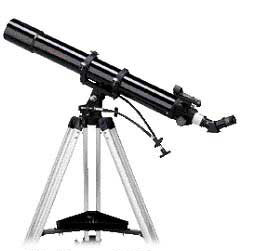 |
A common issue with any standard refractor is
something called chromatic aberration. Recall a
prism and how
light is separated into fundamental
colors of the rainbow. As such, a single lens will
have difficulty focusing the red and blue (either
side of the
visible spectrum) to a single point. In
an effort to correct this flaw, a second and
sometimes third lens are placed together to ensure
single focus. This is the apochromatic and not
surprisingly the price can double or triple compared
to a standard achromat.
Reflecting telescopes use mirrors to focus
light and an eyepiece to magnify. There are two common
classes of reflecting telescopes:
- Newtonian
- Ritchey-Chretien
| Image of the
light path involved with a
Newtonian style telescope. Image provided by
Celestron. |
 |
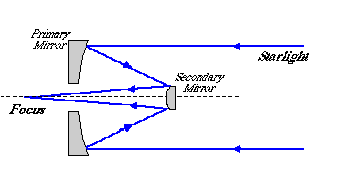 |
The
light path of a Ritchey-Chretien
design is similar to a Schmidt-Cassegrain
but without a corrector plate. |
| A style of Newtonian telescope called
the Dobson - named after the style of mount
- is a popular first choice for a beginning
telescope. It offers a large aperture for a
modest price. Image provided by
Celestron. |
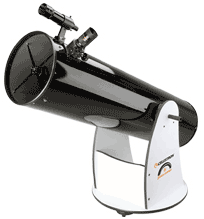 |
Reflecting telescopes eliminate any chromatic
aberrations since
light
does not pass through anything - only reflected.
There is another issue with reflecting (and poorly
designed refractors) telescopes called coma.
Stars will appear stretched towards the edge of
the field of view. Coma is eliminated in the
Ritchey-Chretien design since hyperbolic mirrors
are used - and result in a higher manufacturing
cost.
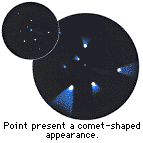 |
This image illustrates what coma could
look like. When looking though a Newtonian
reflector, the
stars the edge of view will
look almost like comas, or
comets. This
affect is more pronounced during
astrophotography. The view at the center
will be unaffected. |
Compound telescopes use a combination of lenses
and mirrors to focus the
light.
- Schmidt-Cassegrain
- Maksutov-Cassegrain
| This image is of a Schmidt-Cassegrain
type of telescope. A corrector plate
eliminates the coma introduced by the
standard Newtonian. Image provided by
Celestron. |
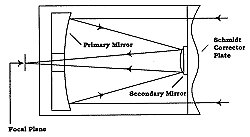 |
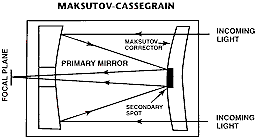 |
The Maksutov-Cassegrain telescope uses a
lens in place of a corrector plate. This
helps overall color and eliminates coma.
Image provided by
Celestron. |
| This image is typical of the Schmidt-Cassegrain
type of telescopes available today.
Celestron was nice enough to let use
their images on this portion of the website,
but oddly enough I have never looked through
a
Celestron telescope. This particular
model is their
NexStar series that boasts a fiber woven
tube for light weight portability and faster
cool-down times and also features the ease
of GPS alignment and a computer for finding
and tracking your favorite objects. These
features are common on a wide variety of
manufactures. |
 |
While the Schmidt-Cassegrain's corrector
plate eliminates the issues of coma, it does not
eliminate coma completely. This is evident is astrophotography, and many seasoned imagers prefer the Ritchey-Chretien because its design eliminates coma completely. The Maksutov-Cassegrain uses a lens
instead of a corrector plate to reduce coma, but to
eliminate chromatic aberration, long focal lengths
are required. As such, the Maksutov-Cassegrain really is best suited for
planetary work - and the
optics can be quite good. So what telescope is
best? There really isn't one, but there are some
guidelines:
- For an inexpensive achromatic refractor,
stay away from short focal lengths - anything
greater than a focal length of f6.5 is good.
- Apochromatic telescopes are very expensive,
and just like high end audio equipment, have
their faithful following. Read reviews and look
for yourself! However, if you plan to use the
telescope for
astrophotography, an apochromatic
telescope is necessary.
- Meade
and
Celestron are the two main producers of the
Schmidt-Cassegrain
telescope. There is not a clear winner as to who
is best, but Meade tends to include more
electronic wizardry into their scopes - which is
fine if you like that sort of thing. Truth is,
competition between these two companies is good
for the consumer as the need for better and
cheaper telescopes are released often.
- Go to a local Astronomy Club or "Star Party"
- a gathering of like minded folks flocking to a
dark location for a night of fun filled
observing. There are sure to be a variety of
telescopes, and most are willing to let you take
a peek.
Astronomy and
Sky and Telescope magazines will have a list
of national events.
To help determine choice, you may want to
know how faint your telescope choice can see -
keeping in mind this is mathematical and may
vary depending on central obstruction of the
telescope and the atmospheric conditions:

An example: a 10" telescope has a
diameter of 254 mm:

The faintest object a 10" telescope
can see is with a visual
magnitude of 14.7 (Pluto
has a
magnitude of around 13.8).
A nice summary of each style of telescope
and its application is:
| Telescope Style |
The Good: |
The Bad: |
| Achromatic |
Inexpensive, good first scope, great
portability |
Chromatic
aberration, often heavy and poorly
designed tubes, not upgradeable |
|
Apochromatic |
Excellent
color, perfect for
photography and
planetary work |
Expensive |
| Newtonian |
Inexpensive, available up to 20" or more |
Not for
photography, coma, large size difficult
to transport, collimation required often |
| Ritchey-Chretien |
Excellent
deep sky work and
photography |
Expensive,
not really suited for visual observation |
| Schmidt-Cassegrain |
Good
all-around telescope |
Large
central obstruction, needs collimation
often |
| Maksutov-Cassegrain |
Good
planetary work, boasts image quality
like an apochromat |
Expensive,
high focal length unsuited for deep sky
observing |
Collimation means adjustment of the
light path. Reflecting telescopes use a small
secondary mirror to focus the
light toward an
eyepiece, and the alignment can suffer due to
excessive movement of even violent temperature
changes. Devices are available at your local
telescope store to help correct this condition.
Back to Top |

